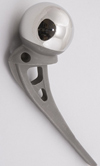Boriding/Boronizing
 In a previous article on the subject of surface treatments, RET Monitor contributor Tom Sharp discussed various surface hardening methods for crankshafts, and the method of nitriding was expanded upon in a subsequent article on the subject of nitride hardening. Not only does nitriding of steels offer a more wear-resistant surface, but there are substantial benefits from the introduction of compressive residual stresses with regard to fatigue behaviour.
In a previous article on the subject of surface treatments, RET Monitor contributor Tom Sharp discussed various surface hardening methods for crankshafts, and the method of nitriding was expanded upon in a subsequent article on the subject of nitride hardening. Not only does nitriding of steels offer a more wear-resistant surface, but there are substantial benefits from the introduction of compressive residual stresses with regard to fatigue behaviour.
Literature is littered with accounts of similar benefits attributed to carburising which is a process whereby carbon is diffused into the surface of a steel. The same favourable combination of improved fatigue strength due to the compressive residual stresses in the surface of the steel and greatly enhanced wear resistance are present for carburising as for nitriding. There are significant differences in the two processes and the resultant properties of the surfaces, and this means that their applications within racing engines are not very common – for example most crankshafts are nitride hardened, and most gears are carburised, although there are exceptions, even at the very top levels of motorsport, to these ‘rules of thumb’.
Therefore we might expect that other surface treatments where elements are diffused into surface layers might lead to the happy combination of increased fatigue life and wear resistance. Whilst there certainly are treatments where this is true (more on these at a later date), it is not a universal truth, and certain diffusion treatments have been proven to reduce fatigue life whilst improving wear resistance. One such case is boriding or boronizing. This process is similar to pack carburising in that the parts are surrounded by a boron rich substance such as a fine powder or granulated medium (although there are boriding pastes on the market) before being taken to elevated temperature for a time during which the boron diffuses into the outer layer of the steel. The processing of the parts after this is again very similar to carburising.
Experimental research by different teams has been reported i ii which shows a deterioration in fatigue life and strength due to this process. The paper by Celik et al focuses on AISI 1010 steel and reports very high surface hardness levels (up to approximately 1500 HV), but greatly reduced fatigue life and strength. The severe loss of fatigue strength (between 14% and 55%) was attributed to the microstructure of the boride containing surface layers. Examination of these layers found that cracks existed in the borided layer. Part of the fatigue life of a part is used in forming the crack, and after this initiation, failure can be rapid. Effectively this portion of the fatigue life of the part, i.e. that part leading to the formation of the crack does not exist in this case, the part having cracks before service loads are applied. The conclusion that can be drawn from examining the evidence presented in these papers is that steel parts may benefit from the increased surface hardness resulting from boriding, but if the parts are cyclically stressed in service, and that these parts do not enjoy a high factor of safety against fatigue failure, then boriding may be a risky route to achieving greater wear resistance.
Written by Wayne Ward.